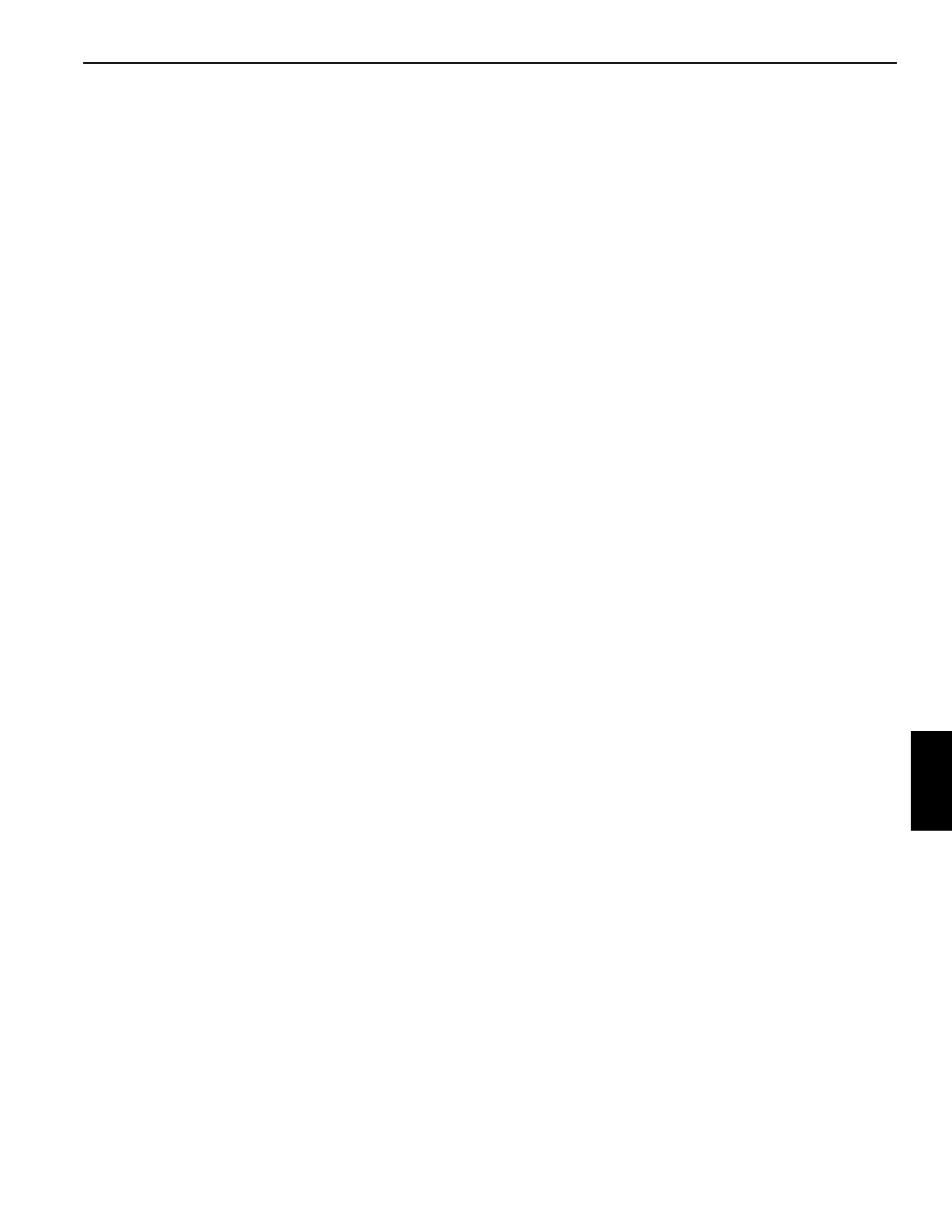Grove Published 11-22-2016, Control # 345-12 7-9
RT9130E-2 SERVICE MANUAL POWER TRAIN
AIR INTAKE AND EXHAUST SYSTEM
Description
There are two air filters available for this machine, depending
on which engine is installed, the tier 3 (Figure 7-3) for export
cranes and the tier 4 (Figure 7-4) for cranes in North America
and some European countries. The air intake system
controls the quality and amount of air available for
combustion. System components are the Air Cleaner,
Turbocharger, Charge Air Cooler, Cylinder Head, and
Exhaust Manifold. Inlet air is pulled through the Air Cleaner,
compressed and heated in the compressor side of the
Turbocharger. The air is pushed through the Charge Air
Cooler to the Air Inlet Manifold. Cooling the inlet air
increases combustion efficiency, lowers fuel consumption,
and increases the horsepower. The air is forced into the
cylinder head to fill the inlet ports. Air flow from the inlet port
into the cylinder is controlled by the intake valves.
Each cylinder has two intake valves and two exhaust valves.
When the intake valves open, cooled compressed air from
the inlet port is pulled into the cylinder. The intake valves
close and the piston begins to move up on the compression
stroke. Fuel is injected into the cylinder and combustion
starts. The piston is forced down and is on the exhaust stroke
when it moves up again. The exhaust valves open and
exhaust is expelled through the exhaust port into the exhaust
manifold.
The exhaust gas from the exhaust manifold enters the
turbine side of the turbocharger and causes the turbine to
turn driving the compressor. Exhaust from the turbocharger
passes through the exhaust pipe and muffler/diesel
particulate filter into the atmosphere.
The Air Cleaner is the dry-type with a replaceable element
and is located on the left rear fender. A service indicator,
designed to indicate red when servicing is required, is
installed in the left center deck and is connected to the Air
Cleaner by plastic air line.
On the Cummins QSC and QSL Engines there are electric
air heating elements that are located in the engine’s intake
air stream. These elements heat the intake air when starting
the engine in cold ambient conditions. Startability and white
smoke control are enhanced by the use of the intake air
heater. A Wait-to-Start Lamp is located on the center front
console to indicate when to crank the engine.
Maintenance
Air Cleaner Checks
Dust passing the Air Cleaner can cause rapid engine wear.
All connections between the Air Cleaner and the engine
must be tight and sealed. If these connections are well
sealed, and there is still evidence of dust leakage, check the
following places for possible trouble.
NOTE: Dust that gets by the air cleaner system can often
be detected by looking for dust streaks on the air
transfer tubing or just inside the intake manifold
inlet.
1. Inspect the air cleaner outlet tube for damage.
2. Ensure the element gasket washer is not damaged and
the washer’s rubber face seals against the element.
3. Inspect the element gasket for damage.
4. Check for structural failures and replace damaged parts.
5. Inspect the restriction indicator tap for leaks.
Check for Filter Restriction
As a dry cleaner element becomes loaded with dust, the
vacuum on the engine side of the air cleaner (at the air
cleaner outlet) increases.
The vacuum is generally measured as restriction in inches of
water or kilopascals. The engine manufacturer places a
recommended limit on the amount of restriction the engine
will stand without loss in performance before the element
must be cleaned or replaced. Cummins allows a vacuum of
25 inches of water (6.2 kPa) maximum with a dirty air cleaner
at maximum governed RPM.
A service indicator on the air cleaner housing will indicate
when the filter needs to be replaced. Reset the indicator
each time the air cleaner is serviced. If the indicator’s
accuracy is suspect, a water manometer is the most
accurate and dependable method of measuring vacuum.
To use the manometer, hold it vertically and fill both legs
approximately half full with water. One of the upper ends is
connected to the restriction tap on the outlet side of the air
cleaner by means of a flexible hose. The other end is left
open to the atmosphere.
Maximum restriction in the air cleaner occurs at maximum air
flow. On this turbocharged diesel engine, the maximum air
flow occurs only at maximum engine power.
With the manometer held vertically and the engine drawing
maximum air, the difference in the height of the water
columns in the two legs, measured in inches or centimeters,
is the air cleaner restriction. Restriction indicators are
generally marked with the restriction at which the red signal
flag locks up. If the initial restriction on a new or clean filter
reads above the maximum allowed for the engine, check the
following items.
1. Ensure the air cleaner inlet is not plugged.
2. Inspect the air cleaner outlet to be sure it is not plugged
by paper, rags, etc.
3. Ensure the correct size connections are used between
the air cleaner and the engine.

